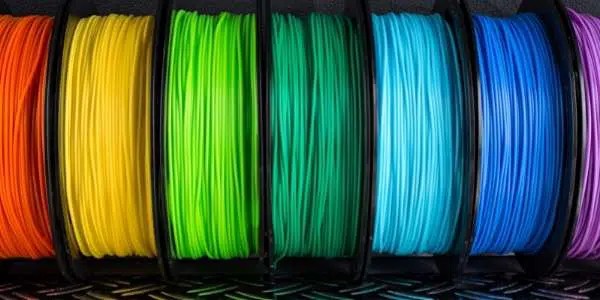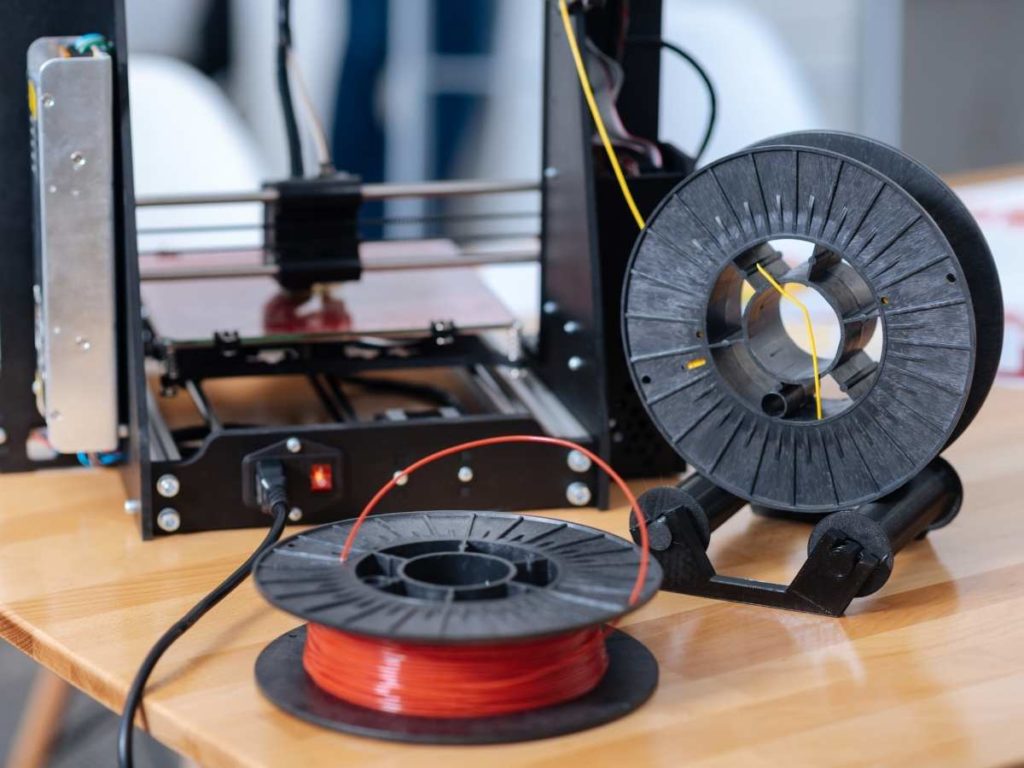PLA filament is an excellent material to use for 3D printing projects. It’s non-toxic, sustainable, and relatively easy to use. However, does your unused PLA filament need to be sealed?
Unused PLA filament needs to be sealed in an airtight container when stored. That is because humidity, as well as dust and dirt particles, can harm the quality of your filament and future 3D printing projects.
The rest of this article will tell you everything you need to know about PLA filament and why you need to keep it sealed up. I’ll also teach you the best methods to store it. So, let’s get into it!
Why You Should Keep Your PLA Filament Sealed
We’ve established that you should keep your PLA filament sealed. However, you may wonder, why is this the case?
Here are some reasons why you should keep your PLA filament sealed:
- Prevent humidity from causing the filament to swell
- Keep dust particles, dirt, and pet hair from contaminating your filament
- Protect it from damage
Let’s discuss each of these reasons in further detail.
Humidity Causes PLA Filament To Swell
Keeping your 3D printing filament sealed is essential for maintaining the quality of your material. That is because the humidity– or moisture level in the air– can cause the filament to swell.
The majority of 3D printing filaments absorb water. So, when you expose it to humidity, it’ll absorb the water molecules in the air.
Swelling is a problem because it can lower the accuracy of your 3D printing project. Because 3D printing relies on precise layers and measurements, PLA filament that has swelled may hurt the structure of your project.
In addition, a filament that has absorbed too much moisture can create visible flaws during the printing process.
Humidity exposure may cause the filament to crack, bubble, break, soften, or release steam. In some cases, it’ll even clog up the nozzle. These unwanted effects will cause inconsistencies in repeated prints and significantly lower the overall quality of your 3D printing creations.
Protect Your PLA Filament From Dust, Dirt, and Pet Hair
The main reason why dust and dirt pose such a problem is that– like excess moisture absorption– it can also lower the quality of your 3D printing projects.
Even the smallest dust particles can cause imperfections in your work, especially noticeable when you’re doing repeated prints.
However, keeping your PLA filament sealed will help keep it safe from the nuisances that come with contamination. Storing your material in a sealed container will drastically reduce contamination because it provides a barrier between the filament and the dirt outside the container.
In addition to keeping your PLA filament sealed, you might want to consider investing in an air purifier if you have a lot of dirt, dust, and pet hair around your home. Air purifiers help reduce these annoying contaminants and keep the environment a lot cleaner, which can help your 3D printing projects stay cleaner as well.
I recommend the Levoit Air Purifier (available on Amazon.com) for its sleek design, excellent ratings, and high functionality. This purifier removes up to 99.97% of unwanted particles to keep your 3D printing endeavors free of contaminating elements.
If you’d rather not invest in an air purifier, there are other ways to keep your PLA filament clean from dust. Another solution is to design or purchase filament dust filters to remove dust from your filament material before printing.
Protect Your PLA Filament From Damage
Another reason why it’s essential to keep your PLA filament sealed in a container is to protect it from damage.
We’re all human, and we’re all prone to the occasional accident. Ensuring that your PLA filament is stored in a container will help keep it safe from situations that might cause damage– such as drops, spills, pet chews, toddler interference, etc.
You can’t go wrong with extra levels of protection for your 3D printing filament, which is why it’s a wise choice to keep your unused PLA filament sealed and stored correctly.
How To Keep Unused PLA Filament Sealed
We’ve talked about why it’s essential to keep your PLA filament sealed when not being used. Now, let’s discuss how you can achieve this.
You can keep your unused PLA filament sealed by storing it in airtight containers specifically designed for 3D printing material. I recommend the Polymaker Filament Storage Box (available on Amazon.com) for its sleek design, built-in thermo-hygrometer, and humidity protection.
If you’re looking for a more affordable option, you should consider the Sunlu Dryer Box Printer Filament (available on Amazon.com).
However, get some vacuum-seal bags and an opaque plastic storage bin for the cheapest route. Seal up your filament in the bag and remove any air.
If you want to take an extra measure of protection, stick some silica gel packs inside the bag with your filament. Then, store the bagged filament inside your opaque container (which will protect it from the harmful rays of UV light from the sun and light bulbs).
What Is PLA Filament?
PLA filament is a 3D printing filament made from polylactic acid, also called polylactide. This polymer material is made from environmentally-friendly components such as roots and starches from corn, potatoes, sugar, and tapioca.
PLA was introduced in the 1930s, but it has recently grown in popularity, especially in 3D printing. PLA filament is favored for its toxin-free makeup, low environmental impact, biodegradability, and ability to bring out the finer details in 3D printing projects.
Benefits of Using PLA Filament for 3D Printing
So, PLA filament requires quite a bit of work to store correctly. You might be wondering whether or not it’s worth it to use PLA filament at all.
Fortunately, PLA filament truly is an excellent choice for 3D printing. Here are a few of the benefits that come with using this material for your printing projects.
PLA Has a Lower Melting Point
In addition to being the more sustainable filament option, PLA is also easier to break down than other 3D printing materials like ABS.
That is because the melting point of PLA filament is much lower than that of ABS.
While PLA melts at just 356°F (180°C) and ABS melts from 392°F (200ºC) to 500°F (260°C). That’s a vast difference in temperature, which is why so many people prefer to use PLA for maximum printing efficiency.
PLA Filament Doesn’t Release Toxic Fumes
Unlike other 3D printing filaments like ABS and nylon, PLA doesn’t release toxic fumes.
It does give off a strong smell. However, this smell is often pleasant because it’s made from natural substances like corn and sugar. It’s also not toxic to inhale.
On the other hand, ABS does release toxic fumes and should only be used sparingly and in adequately-ventilated areas.
Achieve More Color Combinations With PLA Filament
Furthermore, PLA filament comes in a wide range of colors because polylactic acid is easy to dye. Due to this, PLA filament makes it easy to achieve a wide variety of color palettes in your 3D printing projects.
You can also use this easily-pigmented material to create exciting color blends and effects. In addition, you can even dye it yourself at home!
So, overall, its ability to cooperate with color is a significant advantage to using PLA filament.

PLA Filament Is Biodegradable
We mentioned that PLA filament is biodegradable, but what does that mean?
When plastic is biodegradable, this means that it’ll break down under certain conditions. PLA is a biodegradable material since it contains natural starches like potatoes, corn, sugar, and tapioca. These materials will break down when subjected to the right circumstances, meaning that they won’t have as much of a damaging effect on the environment as other harmful plastics.
Conclusion
PLA filament is an excellent material to use for your 3D printing projects. It’s easy to use, sustainable, non-toxic and comes in a wide variety of colors. However, while PLA filament is excellent, it’s not immune to being damaged by factors like humidity and contaminant particles.
That’s why it’s crucial to keep your unused PLA filament sealed. Sealing your filament when not in use is essential to maintaining the quality of this material and the quality of your 3D prints.
- Written by:
- Ben
- Last updated:
- 11/22/2023
About Ben
I started 3D printing since 2013 and have learned a lot since then. Because of this I want to share my knowledge of what I have learned in the past years with the community. Currently I own 2 Bambulab X1 Carbon, Prusa SL1S and a Prusa MK3S+. Hope you learn something from my blog after my years of experience in 3D printing.

